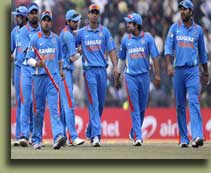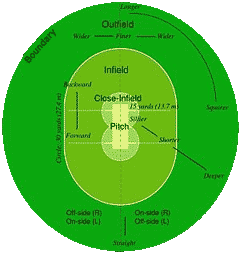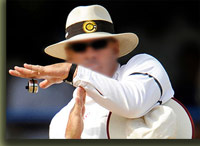One day Cricket The name reflects the rule that in the match each team bowls a set highest number of over's, as a rule between 20 and 50, even though shorter and longer forms of maximum over's cricket have been played. HistoryA "one day match", named so because each match is planned for finishing point in a single day. The one day cricket entertainment has evolved from its first phase around the era of the World Series cricket of the 1970s and is now the mainly watched and most exhilarating form of the game. In the late 1970s, Kerry Packer recognized the contender World Series Cricket (WSC) contest. The worldwide one-day game is a twentieth-century development. The first ODI was played on 5 January 1971 between Australia and England at the Melbourne Cricket Ground.A One Day International (ODI) is a form of Limited over's cricket, in which a rigid number of over's, as a rule 50, but in the past 40, 45 or 60 over's, are played involving two teams with international grade. The Cricket World Cup is played in this configuration. One Day International games are also called "Limited Overs Internationals (LOI)", because they are limited overs cricket matches among national sides, and if the weather mess about they are not always completed in one day. Significant one-day matches, international and domestic, frequently have two days set away, the second day being a "reserve" day to allow more chance of the game being concluded if a result is not achievable on the first day (for illustration if play is not permitted or broken up by rain). Numerous of the aspects of One Day International cricket that are now routine, together with colored uniforms, contests played at hours of darkness under floodlights with a white ball and gloomy sight screens, and, for small screen broadcasts, various camera angles, special effect microphones to arrest sounds from the players on the arena, and on-screen graphics. Teams currently play 50 over's each. RulesIn One day International's, each squad find to bat only a rigid number of over's. In the early years of ODI cricket, the figure of overs was in general 60 overs per side but nowadays it has been consistently set at 50 overs.Basically affirmed the game works as follows:
 Wherever a number of overs are gone astray, for instance, due to rough weather environment, then the number of overs may be condensed. Where the number of overs obtainable for the side batting second is of necessity different from the number of overs faced by the squad that batted first, the result may be firmed by the Duckworth Lewis Method. The floodlights would be placed in such a mode that it would not hinder with fielding side and captains would be permitted a cloth on meadow must the ball become wet. Power PlayThe bowling side is focused to fielding margins insisted on that nine fielders, together with two fielders in catching spot, must be within the fielding circle for a rest number of overs. By tradition, the fielding restrictions apply for the first 15 overs of each innings. The ICC have proclaimed, as of 1 October 2007, with view to Powerplays, that the captain of the fielding team may decide on to position 3 fielders outer the 30 yard circle in one of the two 5-over Powerplays. The law was first invoked in a game between Sri Lanka and England at Dam bulla Stadium on 1 October 2007. At present both 2nd and 3rd power play will boast 3 fielders outside 30 yard circle, and one power play is chosen by batting team. The Test RulesThe trial regulations launched a changeover rule that permitted the opening of a replacement player at any arena in the match. Teams designated their substitute player, called a Supersub, ahead of the toss. The Supersub can bat, bowl, field or keep wicket; the replaced player take no extra part in the game. More than the six months it was in maneuver, it became very plain that the Super sub was of far more gain to the team that won the toss, distort the game. A number of international skipper reached "gentleman's accord" to terminate this rule belatedly in 2005. They persisted to name super subs, as essential, but basically did not field them. On 15 February 2006, the ICC proclaims their objective to break off the Super sub rule on 21 March 2006.Squad with ODI rankThe International Cricket Council (ICC) determines which teams have ODI status. The ten Test-playing nations (which are also the ten full members of the ICC) have enduring ODI status.The nations are filed below with the selection of each nation's ODI debut shown in brackets:
The ICC for the short term grants ODI grade to other teams (known as Associate/Affiliate members at current these are:
One-day recordsThe world record for the peak innings total in any List A restricted overs match is 496 for 4 by Surrey beside Gloucestershire in their Friends Provident Trophy 50-overs game at the Oval, London on April 29th, 2007. The majority runs in an over was attained by Herschelle Gibbs of the South African cricket squad when, in the 2007 Cricket World Cup in the West Indies, he hit 6 sixes in one over bowled by Daan van Bunge of the Netherlands.This testimony is shared by Yuvraj Singh of India who accomplished this feat in the 2007 ICC World Twenty20 in South Africa, he hit 6 sixes in an over bowled by Stuart Broad of England. Sachin Tendulkar seizes the record of being the first male cricketer to achieve a double century in ODIs (200 not out). He accomplished this feat beside South Africa on February 24, 2010, at Gwalior, India. The best bowling facts are 18-19 by Chaminda Vaas for Sri Lanka v Zimbabwe in Colombo, 2001-02 - he is the single player to take eight wickets in a One Day international. |

Home >
Games >
Cricket >
One Day Cricket
Common Games Of India || History Of Games& Sport || Pre School Games || School Games || Games For Girls & Women || Team Games

